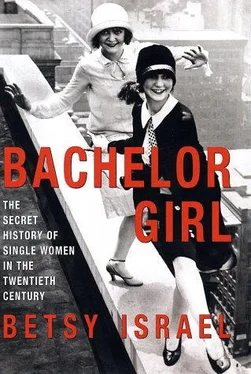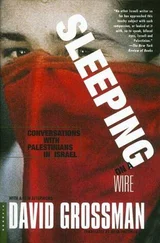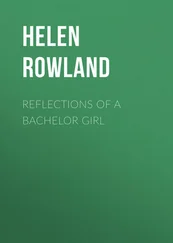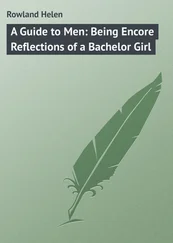I closed my eyes. As if it were a taxi, a Red Cross flying carpet, the lost divan pulled up in my brain. Easing back the silky black covers, I climbed in.
A DIVE INTO THE SINGLE FILES
There is an incredible amount of written material on single women out there. Amazon.com lists 787 current titles, most fitting into one of several single niches. The most obvious is the advice from “the woman who knows” (usually a doctor who goes by a first name such as Dr. Paula or Dr. Joan) to the woman who clearly doesn’t. Nonexpert advice and guidebooks for single women could fill a New Age college catalogue—finding soul mates; learning to love yourself first; identifying obstacles and creatively crashing through them; and how to drag him back using every imaginable part of your body as an arsenal.
There are hundreds of relevant novels, ranging from The House of Mirth, Sister Carrie, and After Leaving Mr. Mackenzie to Fear of Flying, Looking for Mr. Goodbar, and Bridget Jones’s Diary. There are some fascinating academic studies. And there are many interesting if sometimes repetitive journalistic offerings, usually magazine articles (a day/night/week in the life of a single) that grow into books and/or oral histories.
Some of the best oral histories become meditations, as in The Improvised Woman, a wonderful book by journalist Marcelle Clements, in which she alternates subjects’ remarks with her own thoughts—all to explain how thousands of women, thirty-five to fifty-five, found themselves permanently single and raising children alone. This she viewed as nothing less than a radical rewriting of the social contract. Because of this proposition, the book was trashed by critics as “too seventies,” meaning that it seemed too celebratory, too self-consciously groundbreaking— too feminist .
I may as well warn you that there is no way to discuss single life at this point without getting “feminist.” Nearly all American women will for some part of their adult lives exist singly—that is a statistical fact. Some of us will enjoy it, some will feel relieved or depressed or will have no particular views on the subject. And yet we all know that “single” as a social entity has its unique complications. Namely, other people’s sexist attitudes.
A Columbia University senior sighs and says, “You know that, as a woman, single is childlike, younger, and that a mature individual forms combinations…. If, as a woman, you do not, you will come to understand that ‘single,’ as a word, begins with the same letter as ‘stigma.’ …‘Cancer,’ I am sorry to say, has the same number of letters.”
A thirty-six-year-old graphic designer is less glib: “I see my married friends and female relatives mostly when the ‘other half’ is away. They come down to my loft and it’s, like, they’re so amazed to find that it’s really specifically decorated…. And this is even if they’ve been there before . It’s so insulting. I had one friend, a school chum, who seemed paralyzed by my having Le Creuset cookware. It was, like, do you have to have a wedding license to apply for heavy French pots?”
No one has the ability to make the many presumptuous views of single women disappear. But the impact might be diminished by some clear sense of where these sad-girl stereotypes originated, and how, as in a mass game of telephone, they became sadder and more grotesque over time. To track evolving views of single women, I read selectively through one hundred years of newspapers, magazines, and novels. I studied advertisements, caricatures, photographic style, fashion, theater, movies (silent, serial, sound), radio, and TV. I collected high school artifacts (filmstrips, home-ec primers, yearbooks). And I’ve encapsulated relevant academic opinion and research as it filtered down into the mainstream culture.
Most interesting to me and in many ways most useful, I read diaries of women who’d lived singly in 1866–69, 1884–88, 1900, 1942, 1951, 1961–62, 1973–76, and 1999.
The roots of single phobia curl back into antiquity. But I’ve started my investigation with the industrial revolution, and the emergence of displaced single women, specifically the middle-class spinster and the immigrant working girl. I’ve organized the chapters according to the single icons that came after—factory girls, “shoppies,” steno girls, new women, bohemians, Gibson Girls, and the numerous other types that followed them across the twentieth century and into the present. But Bachelor Girl is not a simple pictorial timeline, a semiotic tour that charges through decades, admires the era’s single pinup, then rushes on. Nor is it encyclopedic history. I have combined my historical single archetypes with their rough counterparts now—mostly women in their midthirties and early forties, the point that marks what one magazine editor, forty-four, calls “The Pass-Over Ceremony.” As she explains: “In your twenties, you’re a free bird. You are an unmarried person who has options she hasn’t yet exercised. After the pass over… it’s metamorphosis…. You are viewed, and you know it, as a different woman. An unmarried, as opposed to a merely single, person.”
Along with this primary peer group, I interviewed all over the age map: women in their late teens and twenties, a big eager group now in their fifties and sixties, a few in their seventies, one voluble eighty-five-year-old, plus the occasional ten- or twelve-year-old with strong views about independence as it might affect future careers in veterinary science. Except for the under-twelves, all but one wanted their name and any identifying detail changed. I agreed, of course, but asked that my subjects choose their own pseudonyms. This request seemed appropriate, since many of the earliest single working girls invented fantasy names for themselves. Whether stuck in a factory, behind a store counter, or cleaning someone’s house, the Marys, Hannahs, and Bridgets of the world became for ten to fifteen hours a day Absintheia, Serenissima, Cassamandrina, or my favorite, Briar Desdemona Woods, née Mary O., a seamstress circa 1870 noted for her speed and small stitches.
Because I’ve drawn from the popular media, in its infant and more mature forms, I have narrowed my dig to the feminine icons most consistently held out to represent American womanhood. My primary iconography, therefore, is white, if not always predictably middle-class. Of course women of (all) color have lived out, and continue to live, the single drama, and their personal narratives intersect at many points with those I’ve emphasized. But they make few primary appearances in the public record until occasional stories on the “sad,” “dreary,” or “dead-end” world of the “Negro single,” circa 1966. (It would be impossible, anyway, to do justice to the complexities of the black single experience in this volume. It requires and deserves its own study, and I sincerely hope someone takes on the challenge.) Likewise, I have not included much material on self-defined lesbian women. But I do work through the various ways that “spinster” and “lesbian” have overlapped at times to describe an afeminine woman who, according to prevailing dicta, ranked as a human mutation.
Finally, I have pretty much settled the single woman in New York City, specifically Manhattan, where right now an estimated 1.95 million single women live among some 1.4 million single men. Of course the historical trail of the single leads through Europe and New England, San Francisco, Los Angeles, Chicago, and just about every abandoned suburb and small town in America. (As early as 1868, The Nation noted “…the city is the habitat of the single. The country town or small city is an uncongenial clime for the species.”) But New York City exaggerates the trends and figures—as well as the nasty remarks—that are prevalent everywhere.
Читать дальше












